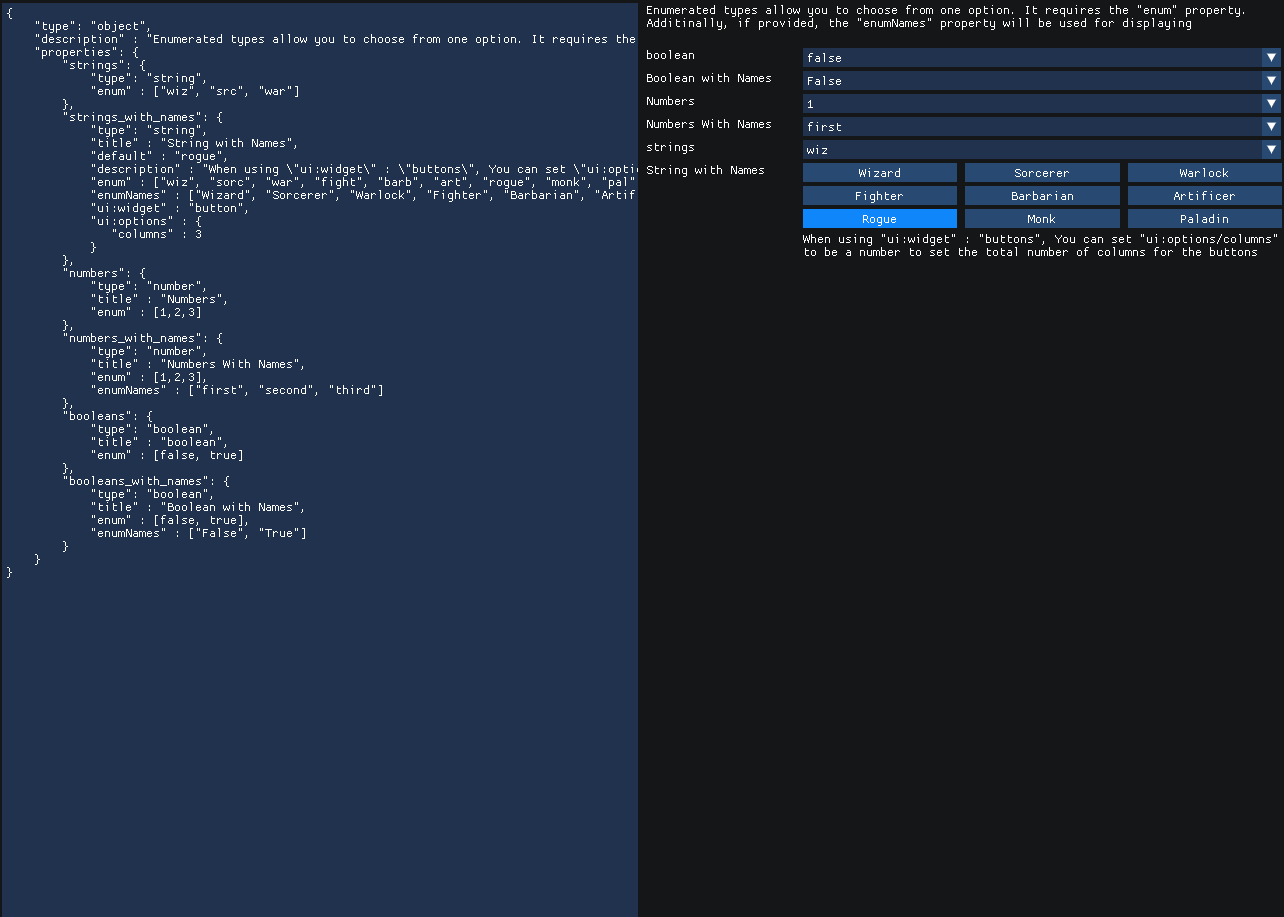An ImGui library to build Form UIs from Json Schemas. Based on React JSON Schema Forms.
- ImGui
- nlohmann::json
The examples uses the Conan Package Manager to download the Json library. It is not required for regular use.
mkdir build
cd build
conan install ..
cmake .. -DCMAKE_BUILD_TYPE=Release
cmake --build . --config=Release
mkdir build_emcc
EMC=PATH/TO/EMSCRIPTEN_SDK
source $EMC/emsdk_env.sh
export CC=$(which emcc)
export CXX=$(which em++)
conan install ../conanfile_emcc.txt -s os=Emscripten -s arch=wasm -s compiler=clang -s compiler.version=17
emcmake cmake ..
cmake --build .
python3 -m http.serverImJSchema is a header-only library. You can include it as a submodule and then add the subdirectory to your CMakeLists.txt file
add_subdirectory(third_party/ImJSchema)
# Link against the target
# Note you must also link against the Nlohmann Json library
target_link_libraries( .... PUBLIC ImJSchema::ImJSchema)There is only one function that you need to use, the drawSchemaWidget.
It requires 3 json objects:
namespace IJS = ImJSchema;
// the schema which that you wish to draw
const auto schema = IJS::json::parse(R"foo(
{
"type": "number"
})foo");
// The value of the widgets will be stored
// in this json object
static ISJ::json value = {};
// The cache used for storing temporary widget data
// such as which index a dropdown menu is currently using
// This is static for the purposes of this example
// but should probably be stored somewhere else
static ISJ::json cache = {};
if(IJS::drawSchemaWidget("object",
value,
schema,
cache))
{
// return a string which contains the JSON path
// of the last modified widget
auto lastWidgetPath = IJS::getModifiedWidgetPath();
std::cout << value.dump(4) << std::endl;
}See examples.cpp. This example provides an overall demo of how the library works and its features
See schenity.cpp for a Zenity like application.
The specification for Json Schemas support references in the form of:
{
"myproperty" : {
"$ref" : "#/$defs/mydefinition"
},
"$defs" : {
"mydefinition" : {
"type" : "number"
}
}
}This library doesn't support references directly, but helper functions are provided to expand a json object which contains references.
auto schema = IJS::json::parse( R"foo(
{
"myproperty" : {
"$ref" : "#/$defs/mydefinition"
},
"$defs" : {
"mydefinition" : {
"type" : "number"
}
}
}
)foo");
IJS::jsonExpandAllReferences(schema);
// or if $defs is in another object:
IJS::jsonExpandAllReferences(schema, definitionsObject);
// you can now call the draw widget function
if(IJS::drawSchemaWidget("object",
value,
schema,
cache))
{
std::cout << value.dump(4) << std::endl;
}You can add your own custom widgets to by providing a lambda function to draw it.
IJS::detail::widgets_all["number/my_custom_number_widget"] =
[](char const* label, IJS::json & value, IJS::json const& _schema, IJS::json & _cache, float object_width) -> bool
{
(void)_sch;
(void)object_width;
auto W = ImGui::GetContentRegionAvail().x;
// Use the "cache" object to store any temporary data
// that may be used for drawing your widget
float w = IJS::JValue(cache, "pos", 0.0f);
w += 1.0f;
if(w > W)
w = 0;
cache["pos"] = w;
if( ImGui::Button(label, {w,0}) )
{
// when you set the value
// make sure you return true
value = value.get<float>() + 1.0f;
return true;
}
return false;
};
You can then use the ui:widget property to use that widget
{
"type" : "number",
"ui:widget" : "my_custom_number_widget"
}



